英文诗歌鉴赏期末作业
- 格式:pptx
- 大小:3.02 MB
- 文档页数:4
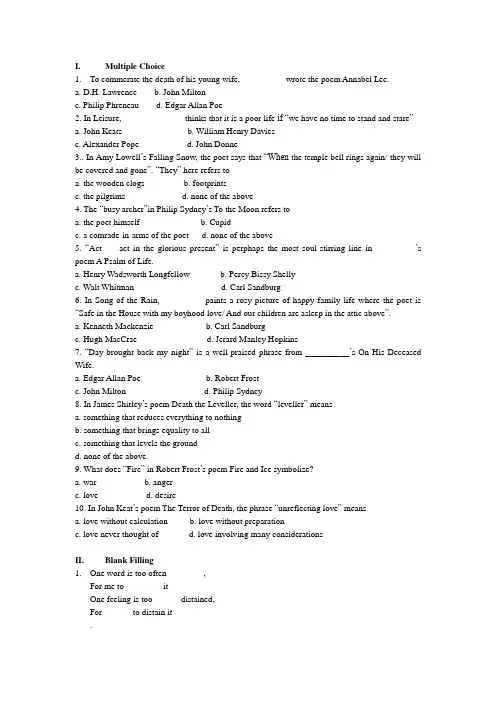
I.Multiple Choice1.To commerate the death of his young wife, __________wrote the poem Annabel Lee.a. D.H. Lawrenceb. John Miltonc. Philip Phreneaud. Edgar Allan Poe2. In Leisure, ____________ thinks that it is a poor life if “we have no time to stand and stare”a. John Keatsb. William Henry Daviesc. Alexander Poped. John Donne3.. In Amy Lowell’s Falling Snow, the poet says that “When the temple bell rings again/ they will be covered and gone”. “They” here refers to ______a. the wooden clogsb. footprintsc. the pilgrimsd. none of the above4. The “busy archer”in Philip Sydney’s To the Moon refers to____a. the poet himselfb. Cupidc. a comrade-in-arms of the poetd. none of the above5. “Act____act in the glorious present”is perphaps the most soul-stirring line in _________’s poem A Psalm of Life.a. Henry Wadsworth Longfellowb. Percy Bissy Shellyc. Walt Whitmand. Carl Sandburg6. In Song of the Rain, _________ paints a rosy picture of happy family life where the poet is “Safe in the House with my boyhood love/ And our children are asleep in the attic above”.a. Kenneth Mackenzieb. Carl Sandburgc. Hugh MacCraed. Jerard Manley Hopkins7. “Day brought back my night”is a well-praised phrase from __________’s On His Deceased Wife.a. Edgar Allan Poeb. Robert Frostc. John Miltond. Philip Sydney8. In James Shirley’s poem Death the Leveller, the word “leveller” meansa. something that reduces everything to nothingb. something that brings equality to allc. something that levels the groundd. none of the above.9. What does “Fire” in Robert Frost’s poem Fire and Ice symbolize?a. warb. angerc. loved. desire10. In John Keat’s poem The Terror of Death, the phrase “unreflecting love” meansa. love without calculationb. love without preparationc. love never thought ofd. love involving many considerationsII.Blank Filling1.One word is too often ________,For me to ________ itOne feeling is too ______distained,For ______ to distain it.2.Make me thy lyre, even as the ___________ isWhat if my _______ are falling like its own,The __________of thy mighty harmonies ,Will take from both a ________autumnal tone___________Seasons of mists and mellow __________Close bosom friend of the______ sun,Conspiring with him how to _______ and blessWith fruit the vines round the thatch eaves ________ 3.When your are old and grey and full of ________And ______by the fire,. take down this bookAnd slowly read, and dream of the ________beautyYour eyes had once, and of their ______deep4.What is this life if, full of __________We have no time to stand and _______No time to see, when ______ we passSquirrels _______their nuts in grassIII.Authorship Identification1. In the world’s broad fields of battle,In the bivuac of life,Be not like dumb, driven cattleBe a hero in the strife.2. The snow whispers about me,And my wooden clogsLeave holes behind me in the snow,But no one will pass this waySeeking my footsteps,3. Her face was veil'd; yet to my fancied sightLove, sweetness, goodness, in her person shin'dSo clear, as in no face with more delight.But O, as to embrace me she inclin'd4. Ethereal minstrel! Pilgrim of the sky!Dost thou despise the earth where cares abound?Or, while the wings aspire, are heart and eyeBoth with thy nest upon the dewy ground?Thy nest which thou canst drop into at will,Those quivering wings composed, that music still!5. No time to turn at beauty’s glance,And watch her feet, how they can danceNo time to wait till her mouth canEnric h that smile her eyes began.6.The CatGreening her eyes on the flame litten mat;Wickedly wakeful, she yawns at the rainBending the roses over the pane7.O world! O life! O time!On whose last steps I climb,Trembling at that where I had stood before;When will return the glory of your prime?8. The glories of our blood and stateAre shadows, not substantials things;There is no armor against fate,Death lays his icy hand on kings9.Whither, ‘midst falling dew,While glow the heavens with the last steps of day,Far, through their rosy depths, dost thou pursueThy solitary way?10. O blest unfabled Incense Tree,That burns in glorious Araby,With red scent chalicing the air,Till earth-life grow Elysian there!IV.True or False1.Like John Donne, John Milton was a metaphisical poet because he liked to philosophizeabout things.2.In his lifetime, Shakespeare published altogether 154 sonnets.3. A free verse is different from a blank verse in that its form is much looser than the latter.4.Emily Dickinson was the first woman poet in the United States.5.Shakespeare never published any other poems than sonnets .6.In Sunflower, William Blake alludes to a Greek myth about a girl who pined away and died asa result of unrequited love7.Robert Browning’s main contribution to English poetry is his invention of the “dramaticmonologue”.8. A major difference between the 19th- century and the 20th- century English poetry is that theformer is more form-conscious while the latter is more content-conscious.9.An Italian sonnet differs from an English sonnet in the way the message of the poem isconveyed: the former is more direct, and the latter indirect.10.Poets like to write about nature because they think nature is beautiful.V.Terminology1.Sonnet2.imagery3.meter4.rhyming schemeI. 1. d 2. b. 3. b. 4. b. 5. a. 6. c. 7. c. 8. b. 9. d. 10 aII.1. profaned , profane, falsely, thee2.forest, leaves, tumult, deep,3.fruitfulness, maturing, load, run4.sleep, nodding, soft, shaddows5.care, stare, woods, hideIII.1.Henry Wadsworth Longfellow, A Psalm of Life2.Amy Lowell, Falling Snow3.John Milton, On His Deceased Mistress4.William Wordsworth, To a Skylark5.William Henry Davies, Leisure6.Huge MacCrae, Song of the Rain7.Pecy Bishhy Shelly, A Lament8.James Shirly, Death the Leveller9.William Cullen Bryant, To a Waterfowl10.George Darley, the PhoenixIV. 1. F. 2. T. 3. T. 4. F. 5. F. .6 T. 7. T. 8. F. 9 F .10 FV.1.sonnet: a form of poetry that originated in Italy, meaning “short song”, containing 14lines that are divided into an octave and a sestet, though English poets like Shakespeare made changes on the structure by turning it into one comprising 3 quartrains and one couplet.2.imagery: figurative language used in poetry containing images as vehicles for expressionof poetical thoughts on the part of the poet.3.meter:systematically arranged and measured rhythm in verse and a measure of unit ofmetrical verse4.rhyming scheme: a regular pattern of rhyme used in verse.。
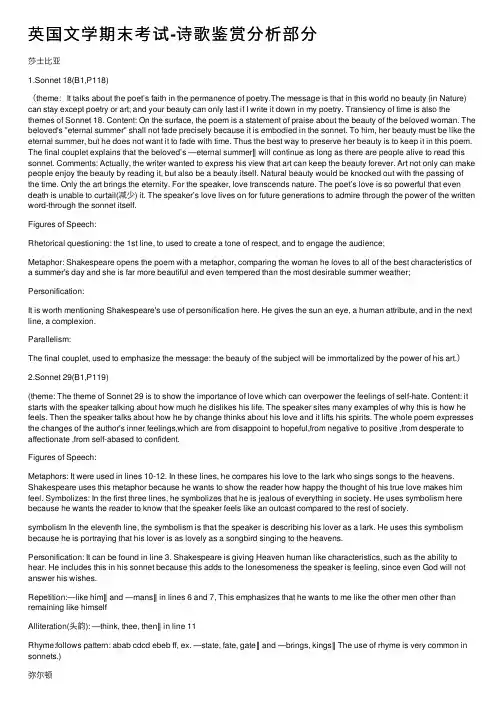
英国⽂学期末考试-诗歌鉴赏分析部分莎⼠⽐亚1.Sonnet 18(B1,P118)(theme:It talks about the poet’s faith in the permanence of poetry.The message is that in this world no beauty (in Nature) can stay except poetry or art; and your beauty can only last if I write it down in my poetry. Transiency of time is also the themes of Sonnet 18. Content: On the surface, the poem is a statement of praise about the beauty of the beloved woman. The beloved's "eternal summer" shall not fade precisely because it is embodied in the sonnet. To him, her beauty must be like the eternal summer, but he does not want it to fade with time. Thus the best way to preserve her beauty is to keep it in this poem. The final couplet explains that the beloved’s ―eternal summer‖ will continue as long as there are people alive to read this sonnet. Comments: Actually, the writer wanted to express his view that art can keep the beauty forever. Art not only can make people enjoy the beauty by reading it, but also be a beauty itself. Natural beauty would be knocked out with the passing of the time. Only the art brings the eternity. For the speaker, love transcends nature. The poet’s love is so powerful that even death is unable to curtail(减少) it. The speaker’s love lives on for future generations to admire through the power of the written word-through the sonnet itself.Figures of Speech:Rhetorical questioning: the 1st line, to used to create a tone of respect, and to engage the audience;Metaphor: Shakespeare opens the poem with a metaphor, comparing the woman he loves to all of the best characteristics of a summer's day and she is far more beautiful and even tempered than the most desirable summer weather; Personification:It is worth mentioning Shakespeare's use of personification here. He gives the sun an eye, a human attribute, and in the next line, a complexion.Parallelism:The final couplet, used to emphasize the message: the beauty of the subject will be immortalized by the power of his art.)2.Sonnet 29(B1,P119)(theme: The theme of Sonnet 29 is to show the importance of love which can overpower the feelings of self-hate. Content: it starts with the speaker talking about how much he dislikes his life. The speaker sites many examples of why this is how he feels. Then the speaker talks about how he by change thinks about his love and it lifts his spirits. The whole poem expresses the changes of the author's inner feelings,which are from disappoint to hopeful,from negative to positive ,from desperate to affectionate ,from self-abased to confident.Figures of Speech:Metaphors: It were used in lines 10-12. In these lines, he compares his love to the lark who sings songs to the heavens. Shakespeare uses this metaphor because he wants to show the reader how happy the thought of his true love makes him feel. Symbolizes: In the first three lines, he symbolizes that he is jealous of everything in society. He uses symbolism here because he wants the reader to know that the speaker feels like an outcast compared to the rest of society.symbolism In the eleventh line, the symbolism is that the speaker is describing his lover as a lark. He uses this symbolism because he is portraying that his lover is as lovely as a songbird singing to the heavens.Personification: It can be found in line 3. Shakespeare is giving Heaven human like characteristics, such as the ability to hear. He includes this in his sonnet because this adds to the lonesomeness the speaker is feeling, since even God will not answer his wishes.Repetition:―like him‖ and ―mans‖ in lines 6 and 7, This emphasizes that he wants to me like the other men other than remaining like himselfAlliteration(头韵): ―think, thee, then‖ in line 11Rhyme:follows pattern: abab cdcd ebeb ff, ex. ―state, fate, gate‖ and ―brings, kings‖ The use of rhyme is very common in sonnets.)弥尔顿3.On His Blindness(B1,P148)(Theme: Its theme is that people use their talent for God, and they serve him best so can endure the suffering best. This sonnet is written as a result of Milton’s grief, as he lost his eye sight at his middle age.Content:Lines 1-8: Milton gets rather impatient at the thought of his blindness in the middle age. Blindness prevents him from using his poetic talent by writing something great to glorify God. In an impatient mood Milton doubts if God would be just in demanding work from a blind man like him.Lines 8-14: Milton’s attitude of doubt passes off in a moment. His inner conscience rises up with its faith in God’s justice. He realizes that God does not need man’s work by way of service to him; nor does he care whether man uses His gifts. He has a lot of angels working for him. So, patient submission to His will is the best service to Him.Figures of Speech:Alliteration: my days in this dark world and wide (line 2)Metaphor: though my soul more bent / To serve therewith my Maker (lines 3-4). The author compares his soul to his mind. Personification/Metaphor: But Patience, to prevent / That murmur, soon replies . . . (lines 8-9).Paradox: They also serve who only stand and wait.Rhyme: This sonnet is written in iambic pentameter rhymed in abba abba cde cde, typical of Italian sonnet. )多恩4.Song(B1, P134)(Theme:Negative view about love. Content: The whole poem focus on the argument of whether beautiful women will be loyalty to love. In the first stanza, he use 6 impossible things to clarify his view that such women who both beautiful and loyalty do not exist in the world. In the second stanza, he describes the journey of a man who was born to strange sights and sware that there were no women true, and fair. In the last stanza, he agreed that it would be sweet if there were women true, and fair, but he won’t change his belief that there exist no women who are both true and fair. Figures of Speech: 第⼀节中⽤了imperative sentence祈使句,像在对话;metaphor将找到美丽⽽忠贞的⼥⼦⽐作第⼀节中的做那些离奇怪诞的事)5.Valediction: Forbidding Mourning: (B1,P135)(Theme:farewell and love. Content:In the first two stanzas the departure of the lovers is compared with the death of virtuous men. Then, he clarify that their love is high to the soul and the body departure cannot influence them any more. Their two souls are united into one like the gold that has excellent ductility. If souls are still two, then they will just like the compasses, separated but never really divided. At last, he asked his wife to take care of the family so that he can complete his missions without worries, just like the moving compass complete a full circle with the help of the fixed point.Figures of Speech:comparison⾼尚男⼈的死和他们的分离;Metaphor(Conceit):The two lovers are likened to the two points of a compass. The idea of the wife staying and minding the house while the husband goes away is old-fashioned now, but we can still comprehend it.Pun: Take the lines Thy firmness makes my circle just,/ And makes me end, where I begun.. Here the compass is doing two different things, and both have significance. "End where I begun" implies the finish of a circle as drawn by a compass; only through his wife's stability in the centre, Donne argues, can his circle be drawn correctly. However it also implies the closing of the compass - and Donne coming home to be with his wife.Symbolism: symbolism of gold is very important, as it is also the most precious and noble of all the metals. It is also the least reactive of all metals, which ties in with Donne's placing of the lovers above the emotional layer and makes their love difficult to destroy.Comments:Donne's basic argument was that most people's relationships are built on purely sensual things - if they are not together at all times, the relationship breaks down. I agree with him, because a real love should have no restrictions of distance or time, so long as lovers’ hearts and souls are bound to each other, there will be no reason for them to worry abouta temporary separation.)布莱德6.Songs of Innocence-The Chimney Sweeper(Theme: This poem protest the living working and conditions, and the overall treatment of youngchimney sweepers in the cities of England; also it expresses sympathy for these young chimney sweepers. Content:The first stanza tells the narrator's life story: abandoned by parents, working in thedark chimney and sleeping in dark, dirty soot. Probably it's the reflection of all the little chimney sweepers' life story. In the thir d line, the cry "'weep! 'weep! 'weep! 'weep!" is actually the child's attempt at saying "Sweep! Sweep! Sweep!", which was the c himney sweeper's street cry.The poem goes on to talk about Tom Dacre, one of the narrator's fellows in the second and third stanzas. The second stanza intr oduces Tom Dacre, who acts as a foil to the speaker. Tom is upset about his lot in life, then the narrator comforts little Tom, sha ving his curl white hair and getting bare, so that he needn't worry that his hair would get spoiled until Tom falls asleep. Here To m's family name "Dacre" is a homophone for the word "dark". In next three stanzas, the poem describes Tom's dream. He drea ms of an angel opening the coffins and freeing the sweepers. It shows the freeing of Tom and other sweeps from the oppressive lifestyle.When the angel tells Tom that ―if he’d be a good boy, He’d have God for his father and never want joy‖, he gives Tom hope that if he is good and does his job, God will be his father and bless him in the next life. Figures of Speech:symbolism,irony)7.Songs of Experience-The Chimney Sweeper(B1,P289)(Theme: This poem protest the living working and conditions, and the overall treatment of youngchimney sweepers in the cities of England; also it expresses sympathy for these young chimney sweepers.Content: In the first two lines, Blake gives us an image of an anguished child in a state of agony. In the second stanza, the child is pictured in a very more happier and playful mood. This soon changes when he decides to tell the stranger more about his parents. They are showed to be punishing their child for being so happy by "clothing in clothes of death and teaching him to sing notes of woe." It is very obvious the sweeper’s feels hate towards his parents for putting him in such sadness, but inst ead he chooses to hide it by making himself look happy and satisfied.It is clear in the last Stanza that Blake’s criticizing the Church, especially, and the state for letting a lot of these things happen. During this time many children were dying from being, either, worked to death or from malnutrition. Neither the state or the church did any thing to stop this and is obviously why Blake feels so much anger towards them. The sweeper’s parents are really no help towards their own child. This makes the reader wonder, if they are worshiping god, the source of good doings, why do they chose to ignore their own child. They would rather turn their heads the other way and instead find love at church. Figures of speech:partial tone:T he cry "'weep! 'weep! " is actually the child's attempt at saying "Sweep! Sweep! ‖,whichwas the chimney sweeper's direct cry. The use of the partial tone creates an ironic effect. It makes readers feel that the chimney children are weeping for their living and working conditions.symbolism,Contrast:In the first two lines, t he color black seems to be very important because it is used to represent sin against innocence, the color of the white snow.)8.Holy Thursday --From Songs of Innocence'(Theme: portrays unfortunate children as blessings to society and shows their gratitude towards God for all that he has done. Figures of speech: simile, metaphor, symbolismBlake tries to express an optimistic and hopeful image of innocent children singing to Christ onthe day of ascension. The poem’s rhythm is playful and childish and effectively carries out Blake’s image.In the first four lines, colorful children are marching into St Paul’s cathedral for the celebration of the ascension of Christ. From the footnote, one learns that these children are from the charity s chools in London, meaning that they are very poor and probably don’t have a family. Despite their hardships, the children are still described in a joyful, harmonic wayWith an ABAB rhyming pattern, the poem starts with a bouncing, nursery rhyme quality. The children’s problems are not an iss ue; they are still cute, innocent, and alive, like a river. The beadles that must keep the kids in order are portrayed as old and lifel ess men who have lost their childhood innocence. Even though these children are poor and homeless, they are showing hopeful ness and optimism when they go to sing the Lord’s praisesIn the next stanza, the children are again portrayed as sweet and innocent, and there is no mention of the hardships they must fa ce every other day in their life. There are a few different images that Blake gives the reader to express his idea that children are pure and free–flowing characters:Here, the children are a beautiful and vital part of the London society. They are ―flowers‖ that give pleasure to all men and wom en. Blake fails to mention that these children are a blight and burden to mankind. They are victims of a cruel and harsh world, a nd as a result, they reflect images of misery and poverty. However, in this stanza, the children are innocent lambs who have a ―r adiance all their own.‖ They are beautiful flowers and are pleasing to the entire world.In the final stanza, the children are singing to the heavens with songs of joy. They are singing the praises of the Lord to heaven on this glorious day.Here, the children are powerful and mighty and are capable of communicating with the heavens above. They believe that God tr uly loves them in spite of the fact that they are really the wretched of the earth. Even though they are penniless and homeless, the children raise their hands and sing their praise and thanks to Jesus.)9.Holy Thursday---From Songs of Experience(Theme: the condemn for the church or the god; sympathy for the poor childrenFigures of speech: contrast, irony, metaphorThis poem is negative and pessimistic and it questions the nature or existence of a God. The children are rejected and abused by society and they are exactly the opposite of the children in the first poem.This procession into the cathedral has religious intentions, but the speaker wonders how holy it is to have so many pitiful and m iserable children in a world that is so rich and prosperous. It doesn’t seem possible to him that these children are singing to the Lord out of pure happiness and thanksgivingThe speaker finds it hard to believe that these children are actually singing out praises of the Lord. He sees them so unhappy an d so poor, and yet they are thanking Jesus for all that he has done for them. The series of questions by the speaker in this stanza implies a tone of disbelief and amazement that heightens throughout the poem.In the last two stanzas, the speaker offers an explanation as to why these children are so poor and pitiful.The speaker believes that the life of the children is always dark, bleak, and bare. It will always be difficult, cold, and barren. He believes that the children are poor because they never have any sunshine or any rain. In other words, these kids don’t have the wonderful and plentiful eye of the Lord upon them. Blake believes that man could not decline into such a pitiful state if God is constantly watching over him. Throughout the ceremony, the children are praising God and all of His works. This prai se now seems very ironic since these children are not under the watchful eye of the Lord)10.The Lamb" --From Songs of Innocence(Theme: the origin of human, blessing for the human and GodContent: The poem begins with the question, ―Little Lamb, who made thee?‖ The speaker, a child, asks the lamb about its origins: how it came into being, how it acquired its particular manner of feeding, its ―clothing‖ of wool, its ―tender voice.‖ In the next stanza, the speaker attempts a riddling answer to his own question: the lamb was made by one who ―calls himself a Lamb,‖ one who resembles in his gentleness both the child and the lamb. The poem ends with the child be stowing a blessing on the lamb.Figures of speech:repetition:Repetition in the first and last couplet of each stanza makes these lines into a refrain, and helps to give the poem its song-like quality.rhetoric questionsSymbolism:The lamb symbolizes Jesus and the image of the child is also associated with Jesus.Comment:The poem is a child’s song, in the form of a question and answer. The first stanza is rural and descriptive, while the second focuses on abstract spiritual matters and contains explanatio n and analogy. The child’s question is both naive and profound. The question (―who made thee?‖) is a simple one, and yet the child is also tapping into the deep and timeless questions that all human beings have, about their own origins and the nature of cr eation. The poem’s apostrophic form contributes to the effect of naivety, since the situation of a child talking to an animal is a believable one, and not simply a literary contrivance. Yet by answering his own question, the child converts it into a rhetorical one, thus counteracting the initial spontaneous sense of the poem. The answer is presented as a puzzle or riddle, and even though it is an easy one—child’s play—this also contributes to an underlying sense of ironic knowingness or artifice in the poem. The child’s answer, however, reveals his confidence in his simple Christian faith and his innocent acceptance of its teachings.)11.The Tiger(B1,P288)(Theme:humans are incapable of fully understanding the mind of God and the mystery of his handiwork.But considering the social background of this poem, It could destroy the old system and establish a new one.Content:This poem begins with the author presents a series of questions that embodies the central problem: Who created the tiger? Or w as it Satan? Blake presents his question in Lines 3 and 4: What immortal hand or eye/ Could frame thy fearful symmetry? However, to express his bewilderment that the God who created the gentle lamb also created the terrifying tiger, he includes Satan as a possible creator while raising his rhetorical questions, the one he asks in Lines 5 and 6: In what distant deeps orskies/Burnt th e fire of thy eyes?Figures of speech:Symbolism:The tiger is symbolic of the revolutionary forces:the French people in the French Revolution to which Blake was a s upporter and it can also symbolizes evil, or the incarnation of evil.And that the lamb represents goodness, or Christ. Metaphor&alliteration:In Lines 3 and 4the author uses alliteration and metaphor to make comparison the tiger and his eyes to fi re.Symbol&Allusion:In Lines 5 and 6: In what distant deeps or skies/Burnt the fire of thy eyes? In these sentences, “Deeps” ap pears to refer to hell and “skies” refer to heaven which is the expression of symbol and Allusion.Comments:It is said that human souls have two sides: a good side, and an evil side."The Lamb" and "The Tyger," by William B lake, are both poems of deep meaning. They seem to explain both sides of human nature: the light and the dark, the yin and the yang, the good and the evil. They can also represent the transition from a child to an adult or even Heaven and Hell. "The Lamb " is a poem that is referring to the good side of the human soul, while "The Tyger" is referring to the dark side. The lamb brings to mind innocence,purity,children,or Jesus; the tiger brings to mind viciousness, cunning, danger, or death. )彭斯12.John Anderson my jo, John(B1, P294)(theme: love. Content:It’s a simple but warm poem about the commonplace feeling of a ordinary couple. The old wife recalls their encounter at their young ages and compare her husband’s young appearance with that of now. They has gone through so many years, and she blesses her husband and wishes joint happiness until their death.Figures of Speech:Metaphor/contrast: In line3 and line6, John’s locks are said to be as black as the raven when young but as white as snow now. The metaphor is so properly used, while the contrast between John’s young and aged years is also very vivid in delivering the massage of their peaceful and lasting marriage.Rhyme:Comments: This poem is very simple, but it remind me of a Chinese saying, ― I’ll take your hand and grow old with you.‖The love I dreamed of is just like this, more stability and less impulsion.)华兹华斯13.The Solitary Reaper(B2,P22)(theme:T he poet is fascinated with a Scottish peasant girl’s beautiful song.Content: Stanza 1: The poet heard a Scottish girl singing while reaping in the wheat field.Stanza 2: The poet is surprised to hear such a beautiful song in so remote aplace.Stanza 3: The poet doesn’t understand her song but knows it is about something sad. Stanza 4: The poet was so moved by her song that he could never forget it.Figures of Speech:Contrast:反衬⽤夜莺和杜鹃反衬少⼥歌声的优美Metaphor/synaesthesia:暗喻、通感声⾳在作者眼中变为有形的事物Vocative:呼语BEHOLD HER /O LISTEN,像在与⼈对话,拉近读者和说话者的距离Repetition:反复同源词反复Analogy:少⼥的歌声与夜莺和杜鹃的歌唱诗⼈与旅⼈及赫布⾥群岛Symbolism: 象征MOUNT UP THE HILL象征着⼈⽣的旅途Rhyme:iniambic tetrameter with the rhyme of ababccdd (except lines 1 & 3 In stanzas 1 and 4)Comments:⽣活中有时停下匆匆的脚步可能会有惊喜。

莆田第四中学2017-2018学年选修课期末测试英语诗歌鉴赏Name : ____________ Mark: ____________Part one: Choose 4 of the 6 questions to answer. (40% 10 for each).1.Write d own your appreciation of the poem Annabel Lee by Allan Poe from one of thefollowing perspectives: the images, musical /sound effect and theme.2. Analyze the striking stylistic features of Dickinson’s I Could Not Stop for Death by listing some exampl es.3.Illustrate the major themes of Stopping by Woods on a Snowy Evening by Robert Frost.4. In the poem I(a by E.E.Cummings the form reinforces the theme. Pl ease make a d etailed analysis.5. Make a detailed analysis of the character Biff or Happy in Arthur Mill er’s Death of a Salesman by referring to the selected part.6. Analyze the characteristics of Emily in A Rose for Emily.Part two: cope the section of a poem; pay attention to your handwriting(30%). Life, thin and light-off time and time againFrivolous tirelessI heard the echo, from the valleys and the heartOpen to the lonely soul of sickle harvestingRepeat outrightly, but also repeat the well-being ofEventually swaying in the desert oasisI believe I amBorn as the bright summer flowersDo not withered undefeated fiery demon ruleHeart rate and breathing to bear the load of the cumbersomeBored_________________________________________________________________________________________________ ________________________________________________________________________________________________ _______________________________________________________________________________________________ _______________________________________________________________________________________________ _______________________________________________________________________________________________ _______________________________________________________________________________________________ _______________________________________________________________________________________________ _______________________________________________________________________________________________ _______________________________________________________________________________________________ _______________________________________________________________________________________________ _______________________________________________________________________________________________ Part three: write down a poem you learnt in the course(30%)._________________________________________________________________________________________________ ________________________________________________________________________________________________ _______________________________________________________________________________________________ _______________________________________________________________________________________________ _______________________________________________________________________________________________ _______________________________________________________________________________________________ _______________________________________________________________________________________________ _______________________________________________________________________________________________ _______________________________________________________________________________________________ _______________________________________________________________________________________________~~~~~~~~~~~~~~~~~~~~~ The End ~~~~~~~~~~~~~~~~~~~~~。
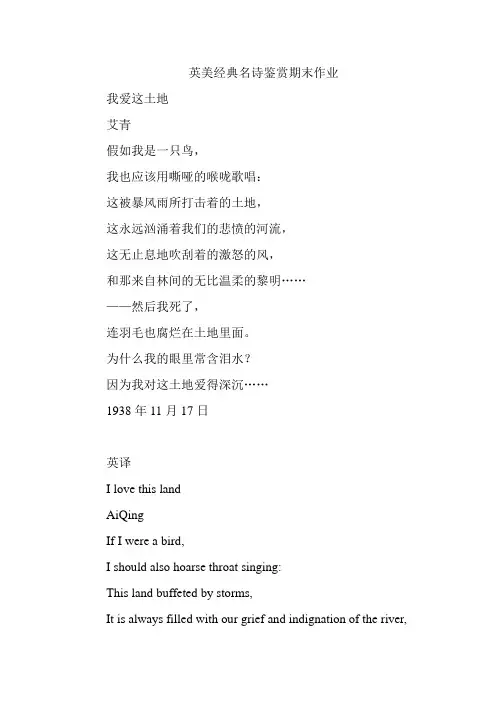
英美经典名诗鉴赏期末作业我爱这土地艾青假如我是一只鸟,我也应该用嘶哑的喉咙歌唱:这被暴风雨所打击着的土地,这永远汹涌着我们的悲愤的河流,这无止息地吹刮着的激怒的风,和那来自林间的无比温柔的黎明……——然后我死了,连羽毛也腐烂在土地里面。
为什么我的眼里常含泪水?因为我对这土地爱得深沉……1938年11月17日英译I love this landAiQingIf I were a bird,I should also hoarse throat singing:This land buffeted by storms,It is always filled with our grief and indignation of the river,The ceaseless blows violently angry wind,And then from the soft dawn......-- then I die,Even the feathers rotted in the land.Why there are tears in my eyes?Because I love the land so much......November 17, 1938《我爱这土地》是中国著名现代诗人艾青的代表作。
该诗写于1938年的武汉。
当时日寇侵华,中华民族正陷入严重的民族危机之中,亡国灭种的危险时刻存在。
人民陷入巨大的痛苦之中,水深火热。
有识之士都在为抗日守土,保家卫国而呐喊。
诗人艾青便是众多爱国知识分子中的一位。
全诗分为两节。
第一节是从虚处落笔,别开生面的提出自己是一只鸟,继而说出自己的抒情对象,“生于斯,长于斯,至死不渝”。
表现了诗人对土地的深挚的、执著的爱。
及作为一名中国人的不凡气魄与担当。
第二节是从实处落笔,笔锋一转,再一次强烈而深沉的抒发了对家国的热爱,一切真切而炽热的感情全部蕴藏在那“泪水”之中,发自肺腑,气动乾坤。

高二英语英语诗歌鉴赏练习题30题1.In the poem, "The moon shines bright on the still lake." What is the main image?A.sunB.moonC.starD.cloud答案:B。
解析:这首诗中明确提到“The moon shines bright on the still lake.”,所以主要意象是月亮。
选项A 太阳在诗中未出现;选项C 星星在诗中未出现;选项D 云在诗中未出现。
2."A red rose blooms in the garden." What is the key image here?A.lilyB.daisyC.roseD.sunflower答案:C。
解析:诗中提到“A red rose blooms in the garden.”,主要意象是玫瑰。
选项A 百合花在诗中未出现;选项B 雏菊在诗中未出现;选项D 向日葵在诗中未出现。
3."The wind whispers through the trees." What is the main image?A.rainB.windC.snow答案:B。
解析:诗中“The wind whispers through the trees.”表明主要意象是风。
选项A 雨在诗中未出现;选项C 雪在诗中未出现;选项D 雾在诗中未出现。
4."A lonely bird flies across the sky." What is the main image?A.butterflyB.beeC.birdD.spider答案:C。
解析:诗中“A lonely bird flies across the sky.”说明主要意象是鸟。
选项A 蝴蝶在诗中未出现;选项B 蜜蜂在诗中未出现;选项D 蜘蛛在诗中未出现。
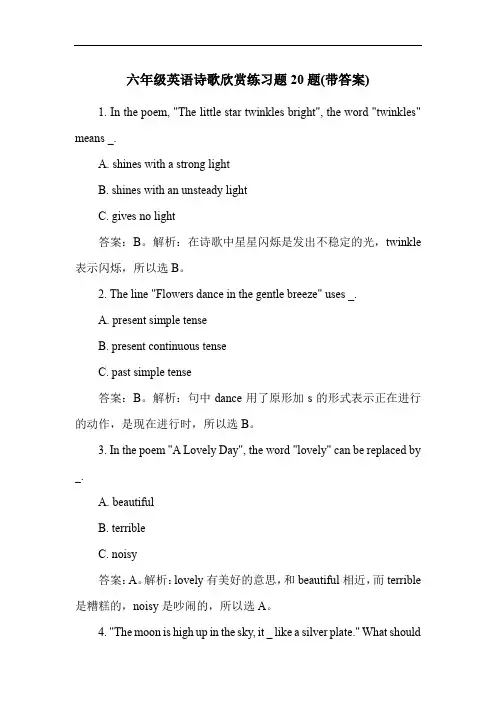
六年级英语诗歌欣赏练习题20题(带答案)1. In the poem, "The little star twinkles bright", the word "twinkles" means _.A. shines with a strong lightB. shines with an unsteady lightC. gives no light答案:B。
解析:在诗歌中星星闪烁是发出不稳定的光,twinkle 表示闪烁,所以选B。
2. The line "Flowers dance in the gentle breeze" uses _.A. present simple tenseB. present continuous tenseC. past simple tense答案:B。
解析:句中dance用了原形加s的形式表示正在进行的动作,是现在进行时,所以选B。
3. In the poem "A Lovely Day", the word "lovely" can be replaced by _.A. beautifulB. terribleC. noisy答案:A。
解析:lovely有美好的意思,和beautiful相近,而terrible 是糟糕的,noisy是吵闹的,所以选A。
4. "The moon is high up in the sky, it _ like a silver plate." What shouldbe filled in the blank?A. lookB. looksC. looked答案:B。
解析:句子描述的是一种客观事实,月亮看起来像银盘,用一般现在时,主语是it,动词用第三人称单数形式,所以选B。
5. In the poem about seasons, "Spring brings new life", the subject is _.A. SpringB. new lifeC. brings答案:A。
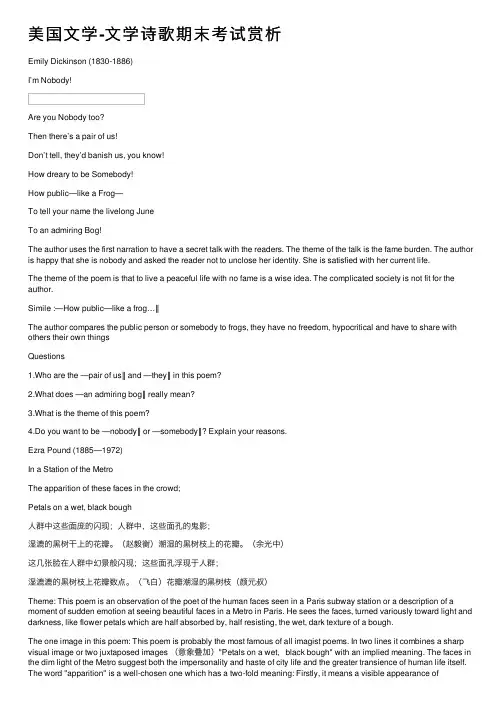
美国⽂学-⽂学诗歌期末考试赏析Emily Dickinson (1830-1886)I’m Nobody!Are you Nobody too?Then there’s a pair of us!Don’t tell, they’d banish us, you know!How dreary to be Somebody!How public—like a Frog—To tell your name the livelong JuneTo an admiring Bog!The author uses the first narration to have a secret talk with the readers. The theme of the talk is the fame burden. The author is happy that she is nobody and asked the reader not to unclose her identity. She is satisfied with her current life.The theme of the poem is that to live a peaceful life with no fame is a wise idea. The complicated society is not fit for the author.Simile :―How public—like a frog…‖The author compares the public person or somebody to frogs, they have no freedom, hypocritical and have to share with others their own thingsQuestions1.Who are the ―pair of us‖ and ―they‖ in this poem?2.What does ―an admiring bog‖ really mean?3.What is the theme of this poem?4.Do you want to be ―nobody‖ or ―somebody‖? Explain your reasons.Ezra Pound (1885—1972)In a Station of the MetroThe apparition of these faces in the crowd;Petals on a wet, black bough⼈群中这些⾯庞的闪现;⼈群中,这些⾯孔的⿁影;湿漉的⿊树⼲上的花瓣。

七年级英语诗歌欣赏20题1<背景文章>Spring is a beautiful season. When spring comes, the world wakes up from its long winter sleep. The grass turns green, and the flowers start to bloom. The trees are filled with new leaves. The birds sing happily in the trees. The sun shines brightly, and the air is warm and fresh.In spring, people like to go out and enjoy the beautiful weather. They go for picnics in the park, fly kites in the fields, and take walks in the countryside. Spring is a time of renewal and hope.The following is a poem about spring:And all is right.And full of fun.1. What season does the poem describe?A. WinterB. SummerC. AutumnD. Spring答案:D。
解析:文章明确提到“The following is a poem about spring”,可知这首诗描述的是春天。
2. What do the birds do in spring?A. SleepB. CryC. SingD. Hide答案:C。
解析:文中提到“The birds sing happily in the trees.”以及“The birds sing, The bees hum”,可知鸟儿在春天唱歌。
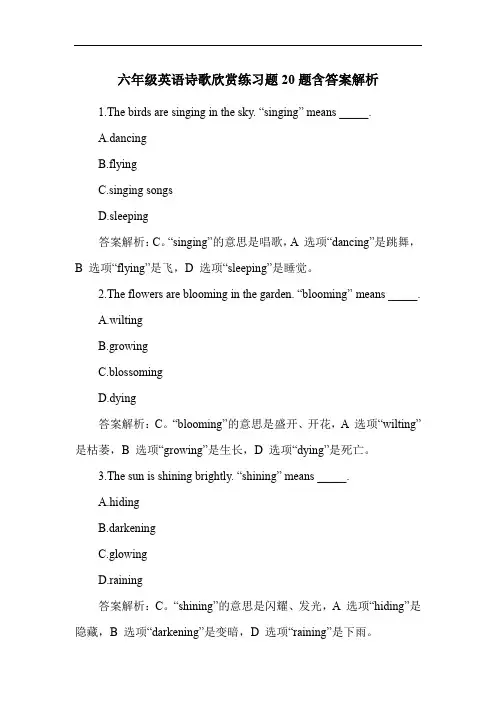
六年级英语诗歌欣赏练习题20题含答案解析1.The birds are singing in the sky. “singing” means _____.A.dancingB.flyingC.singing songsD.sleeping答案解析:C。
“singing”的意思是唱歌,A 选项“dancing”是跳舞,B 选项“flying”是飞,D 选项“sleeping”是睡觉。
2.The flowers are blooming in the garden. “blooming” means _____.A.wiltingB.growingC.blossomingD.dying答案解析:C。
“blooming”的意思是盛开、开花,A 选项“wilting”是枯萎,B 选项“growing”是生长,D 选项“dying”是死亡。
3.The sun is shining brightly. “shining” means _____.A.hidingB.darkeningC.glowingD.raining答案解析:C。
“shining”的意思是闪耀、发光,A 选项“hiding”是隐藏,B 选项“darkening”是变暗,D 选项“raining”是下雨。
4.The wind is blowing gently. “blowing” means _____.A.stoppingB.calmC.flowingD.moving air答案解析:D。
“blowing”的意思是吹、刮风,也就是空气的流动,A 选项“stopping”是停止,B 选项“calm”是平静的,C 选项“flowing”通常指液体的流动。
5.The stars are twinkling in the night. “twinkling” means _____.A.shining steadilyB.flashingC.dimmingD.disappearing答案解析:B。
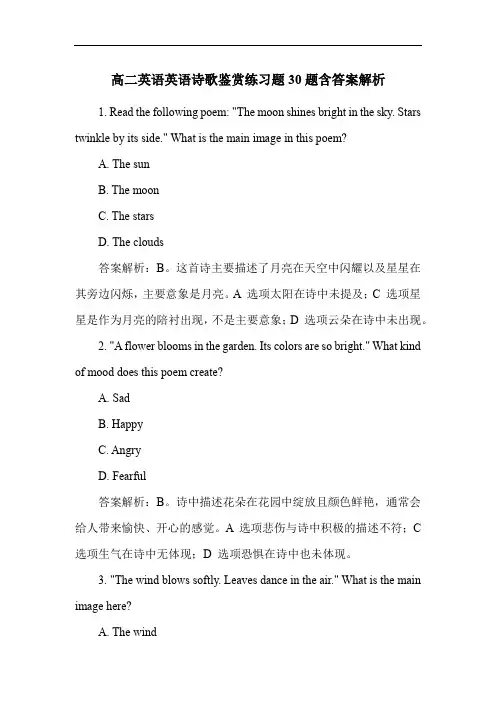
高二英语英语诗歌鉴赏练习题30题含答案解析1. Read the following poem: "The moon shines bright in the sky. Stars twinkle by its side." What is the main image in this poem?A. The sunB. The moonC. The starsD. The clouds答案解析:B。
这首诗主要描述了月亮在天空中闪耀以及星星在其旁边闪烁,主要意象是月亮。
A 选项太阳在诗中未提及;C 选项星星是作为月亮的陪衬出现,不是主要意象;D 选项云朵在诗中未出现。
2. "A flower blooms in the garden. Its colors are so bright." What kind of mood does this poem create?A. SadB. HappyC. AngryD. Fearful答案解析:B。
诗中描述花朵在花园中绽放且颜色鲜艳,通常会给人带来愉快、开心的感觉。
A 选项悲伤与诗中积极的描述不符;C 选项生气在诗中无体现;D 选项恐惧在诗中也未体现。
3. "The wind blows softly. Leaves dance in the air." What is the main image here?A. The windB. The leavesC. The airD. The ground答案解析:A。
这首诗主要强调风轻轻吹,使得树叶在空中舞动,主要意象是风。
B 选项树叶是在风的作用下舞动,不是主要意象;C 选项空气在诗中是树叶舞动的环境,不是主要意象;D 选项地面在诗中未提及。
4. "A brook flows quietly. Birds sing nearby." What kind of atmosphere does this poem create?A. NoisyB. PeacefulC. ExcitingD. Frightening答案解析:B。
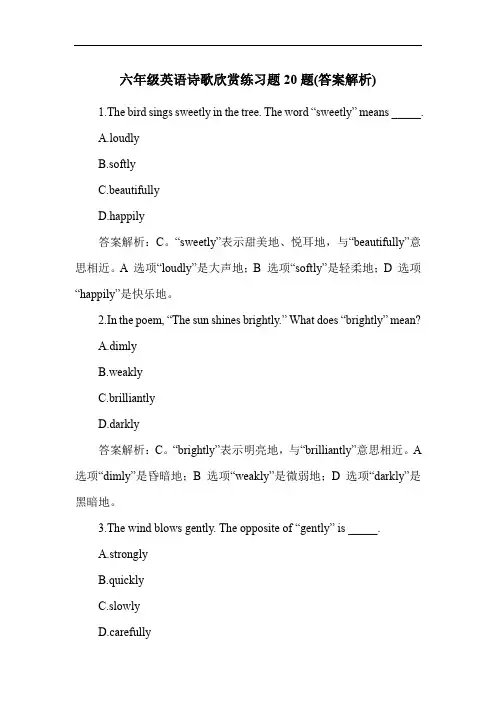
六年级英语诗歌欣赏练习题20题(答案解析)1.The bird sings sweetly in the tree. The word “sweetly” means _____.A.loudlyB.softlyC.beautifullyD.happily答案解析:C。
“sweetly”表示甜美地、悦耳地,与“beautifully”意思相近。
A 选项“loudly”是大声地;B 选项“softly”是轻柔地;D 选项“happily”是快乐地。
2.In the poem, “The sun shines brightly.” What does “brightly” mean?A.dimlyB.weaklyC.brilliantlyD.darkly答案解析:C。
“brightly”表示明亮地,与“brilliantly”意思相近。
A 选项“dimly”是昏暗地;B 选项“weakly”是微弱地;D 选项“darkly”是黑暗地。
3.The wind blows gently. The opposite of “gently” is _____.A.stronglyB.quicklyC.slowlyD.carefully答案解析:A。
“gently”是轻柔地,反义词是“strongly”强烈地。
B 选项“quickly”是快速地;C 选项“slowly”是缓慢地;D 选项“carefully”是小心地。
4.“The flower is colorful.” What’s the meaning of “colorful”?A.blackB.whiteC.dullD.vivid答案解析:D。
“colorful”表示色彩鲜艳的,与“vivid”意思相近。
A 选项“black”是黑色的;B 选项“white”是白色的;C 选项“dull”是暗淡的。
5.In the poem, “The stars twinkle in the sky.” What does “twinkle” mean?A.shineB.blinkC.fadeD.disappear答案解析:B。
九年级英语诗歌鉴赏练习题40题1.In the poem, "The bright sun shines on the meadow." What does "meadow" mean?A.forestB.fieldC.gardenD.mountain答案:B。
“meadow”意为草地、牧场,与“field”(田野)意思较为接近。
“forest”是森林;“garden”是花园;“mountain”是山。
在诗歌中,通常“meadow”用来描绘开阔的自然场景,这里结合“sun shines”可知是较为开阔的地方,所以“field”更符合。
2."The gentle breeze caresses the flowers." What does "caresses" mean?A.hitsB.blowsC.kissesD.pushes答案:C。
“caresses”有轻抚、爱抚之意。
“hits”是击打;“blows”是吹;“kisses”有轻吻之意,比较接近“caresses”;“pushes”是推。
在诗歌中,“gentle breeze”((轻柔的微风)与“caresses”搭配,表达出温柔的感觉,“kisses”更能体现这种温柔。
3."The clear stream flows through the valley." What does "valley"mean?A.riverkeC.hillD.depression between mountains答案:D。
“valley”是山谷,即两山之间的低洼地带。
“river”是河流;“lake”是湖泊;“hill”是小山。
在诗歌中,“stream flows through”((溪流流过)的地方通常是山谷。
4."The radiant moon illuminates the night." What does "radiant" mean?A.darkB.brightC.smallrge答案:B。
高二英语英语诗歌鉴赏练习题30题1<背景文章>Love is a many-splendored thing. This is a line from a famous English love poem. Poetry has always been a powerful medium to express love. One of the most classic love poems is Shakespeare's Sonnet 18.Shakespeare's Sonnet 18 is widely regarded as one of the most beautiful love poems in English literature. The poem was written in the 16th century and is still loved and admired by people all over the world. The background of this sonnet is thought to be Shakespeare's admiration for a young man or a woman. The theme of the poem is the eternal beauty of the beloved. The poet compares the beauty of the beloved to a summer's day, but then goes on to say that the beloved's beauty is even more lasting.The imagery in Sonnet 18 is rich and vivid. Shakespeare uses the imagery of summer, the sun, and the wind to describe the beauty of the beloved. The artistry of the poem lies in its use of rhyme, meter, and metaphor. The sonnet is written in iambic pentameter, which gives it a musical quality. The use of metaphor, such as comparing the beloved to a summer's day, makes the poem more vivid and expressive.In conclusion, Shakespeare's Sonnet 18 is a masterpiece of English love poetry. Its beauty lies in its rich imagery, artful use of language, andtimeless theme of love.1. What is the background of Shakespeare's Sonnet 18?A. Shakespeare's love for his wife.B. Shakespeare's admiration for a young man or a woman.C. Shakespeare's description of nature.D. Shakespeare's criticism of society.答案:B。
七年级英语诗歌鉴赏练习题50题含答案解析1.In the poem, the main idea is about _____.A.natureB.friendshipC.familyD.school答案解析:A。
本题考查对诗歌主题的理解。
选项A“nature”( 自然),如果诗歌中描述了山川、河流、花草树木等自然元素,那么主题很可能是自然。
选项B“friendship” 友谊),通常会有关于朋友之间的互动、情感等内容。
选项C“family”( 家庭),会涉及到家庭成员之间的关系等。
选项D“school”( 学校),会有与学校生活相关的场景。
这首诗中主要描写了自然风景,所以主题是自然。
2.The theme of the poem is most likely _____.A.loveB.adventureC.hopeD.sadness答案解析:C。
选项A“love”(爱),一般会有关于爱情、亲情等表达。
选项B“adventure” 冒险),会有刺激的经历等描述。
选项C“hope”(希望),如果诗歌中有积极向上、对未来的期待等内容,主题可能是希望。
选项D“sadness”( 悲伤),会有让人感到难过的情景。
这首诗中充满了对未来的憧憬和积极的情感,所以主题是希望。
3.What is the main theme of the poem?A.courageB.peaceC.angerD.happiness答案解析:B。
选项A“courage”( 勇气),通常有面对困难时的勇敢表现。
选项B“peace”( 和平),可能有宁静的氛围、和谐的场景等。
选项C“anger”( 愤怒),会有让人愤怒的事情发生。
选项D“happiness” 幸福),会有让人感到开心的事情。
这首诗营造了一种宁静和谐的氛围,所以主题是和平。
4.The poem is mainly about _____.A.lossB.winC.dreamD.truth答案解析:D。
七年级英语诗歌鉴赏练习题30题1. In the poem, “The bird sings merrily.” What does “merrily” mean?A. sadlyB. happilyC. angrilyD. quietly答案解析:B。
“merrily”的意思是“愉快地、高兴地”。
A 选项“sadly”是“悲伤地”;C 选项“angrily”是“生气地”;D 选项“quietly”是“安静地”。
在这句诗中,鸟唱歌应该是愉快的,所以选B。
2. “The flower blooms brightly.” What does “blooms” mean?A. wiltsB. growsC. opensD. fades答案解析:C。
“blooms”的意思是“开花、绽放”。
A 选项“wilts”是“枯萎”;B 选项“grows”是“生长”;D 选项“fades”是“褪色、凋谢”。
在这句诗中,花应该是开放的状态,所以选C。
3. “The wind blows gently.” What does “gently” mean?A. stronglyB. quicklyC. softlyD. loudly答案解析:C。
“gently”的意思是“轻轻地、温柔地”。
A 选项“strongly”是“强烈地”;B 选项“quickly”是“快速地”;D 选项“loudly”是“大声地”。
在这句诗中,风应该是轻柔地吹,所以选C。
4. “The sun shines brightly.” What does “shines” mean?A. hidesB. setsC. risesD. glows答案解析:D。
“shines”的意思是“发光、照耀”。
A 选项“hides”是“隐藏”;B 选项“sets”是“落下”;C 选项“rises”是“升起”。
在这句诗中,太阳应该是发光的状态,所以选D。
5. “The stars twinkle in the sky.” What does “twinkle” mean?A. disappearB. shine steadilyC. flash on and offD. move quickly答案解析:C。
七年级英语文学作品赏析练习题50题含答案解析1.In the story, the main character is brave, kind and _____.zyB.cleverC.shyD.mean答案解析:B。
选项A“lazy”意为懒惰,故事中的主角积极勇敢且善良,不符合懒惰的特点。
选项C“shy”意为害羞,文中主角的行为表现并不体现害羞。
选项D“mean”意为吝啬、刻薄,与主角的性格特点不符。
而选项B“clever”聪明,在故事中主角面对问题能够想出办法解决,体现出聪明的特点。
2.The character in the book is helpful, friendly and _____.A.rudeB.honestC.dishonestD.cruel答案解析:B。
选项A“rude”粗鲁,与文中人物乐于助人、友好的形象不符。
选项C“dishonest”不诚实,文中未体现人物不诚实的行为。
选项D“cruel”残忍,与人物形象相悖。
选项B“honest”诚实,与人物乐于助人、友好的形象相呼应。
3.The hero in the story is strong, courageous and _____.A.weakB.cowardlyC.smartD.arrogant答案解析:C。
选项A“weak”虚弱,与英雄强壮的形象矛盾。
选项B“cowardly”胆小,与英雄勇敢的形象不符。
选项D“arrogant”傲慢,文中未体现英雄傲慢的特点。
选项C“smart”聪明,英雄在故事中面对困难能机智应对,体现聪明的特点。
4.The girl in the novel is gentle, polite and _____.A.impoliteB.rudeC.noisyD.quiet答案解析:D。
选项A“impolite”不礼貌,与女孩温柔、有礼貌的形象不符。
选项B“rude”粗鲁,也不符合女孩的形象。
七年级英语英文诗歌赏析练习题50题答案解析版1. In the poem, the author mainly talks about _____.A. natureB. friendshipC. familyD. school答案解析:A。
这首诗中描述了很多自然的景象,如花朵、树木、鸟儿等,所以主题是自然。
B 选项友谊在诗中没有体现。
C 选项家庭也未在诗中出现。
D 选项学校同样与这首诗无关。
2. The theme of the poem is _____.A. loveB. happinessC. sadnessD. courage答案解析:B。
诗中充满了积极向上的情感和快乐的描述,如阳光、微笑等,所以主题是幸福快乐。
A 选项爱没有在诗中有明显体现。
C 选项悲伤与诗的氛围不符。
D 选项勇气在诗中未涉及。
3. What is the main topic of the poem?A. animalsB. sportsC. seasonsD. hobbies答案解析:C。
诗中提到了不同季节的特点,如春天的花朵、夏天的阳光、秋天的落叶、冬天的雪花,所以主题是季节。
A 选项动物在诗中没有出现。
B 选项体育与诗无关。
D 选项爱好也不在诗中。
4. The poem is mainly about _____.A. dreamsB. memoriesC. hopesD. travels答案解析:A。
诗中多次提到梦想,如“my dreams fly high”等,所以主题是梦想。
B 选项回忆在诗中未体现。
C 选项希望虽然有积极的含义,但不如梦想在诗中明确。
D 选项旅行在诗中没有涉及。
5. What's the theme of this poem?A. musicB. artC. booksD. nature答案解析:D。
诗中描写了大自然的美丽,如山、水、风等,所以主题是自然。
A 选项音乐在诗中没有体现。